Higher National Diploma Business Environment Analysis: Toyota Report
VerifiedAdded on 2021/02/08
|33
|16055
|131
Report
AI Summary
This report provides a comprehensive analysis of Toyota's business environment and organizational structure, focusing on its operations within the global market. It begins with an introduction to the business environment, defining its components and their influence on business operations, alongside an overview of different organizational types, including public, private, and voluntary sectors, and their respective legal structures. The report then delves into Toyota's corporate structure, size, and scope, examining its responses to market changes, competition, and technological advancements. It explores various organizational structures, such as functional, matrix, and hierarchical, and analyzes the interrelationships between organizational functions and their impact on organizational objectives. Furthermore, the report applies the PESTLE model to analyze the macro environment and uses SWOT/TOWS analysis to assess strengths, weaknesses, opportunities, and threats, influencing decision-making. The analysis considers both macro and micro factors, evaluating their impacts on Toyota's objectives and strategic decisions, concluding with insights into how Toyota adapts and maintains its competitive position in the automotive industry.
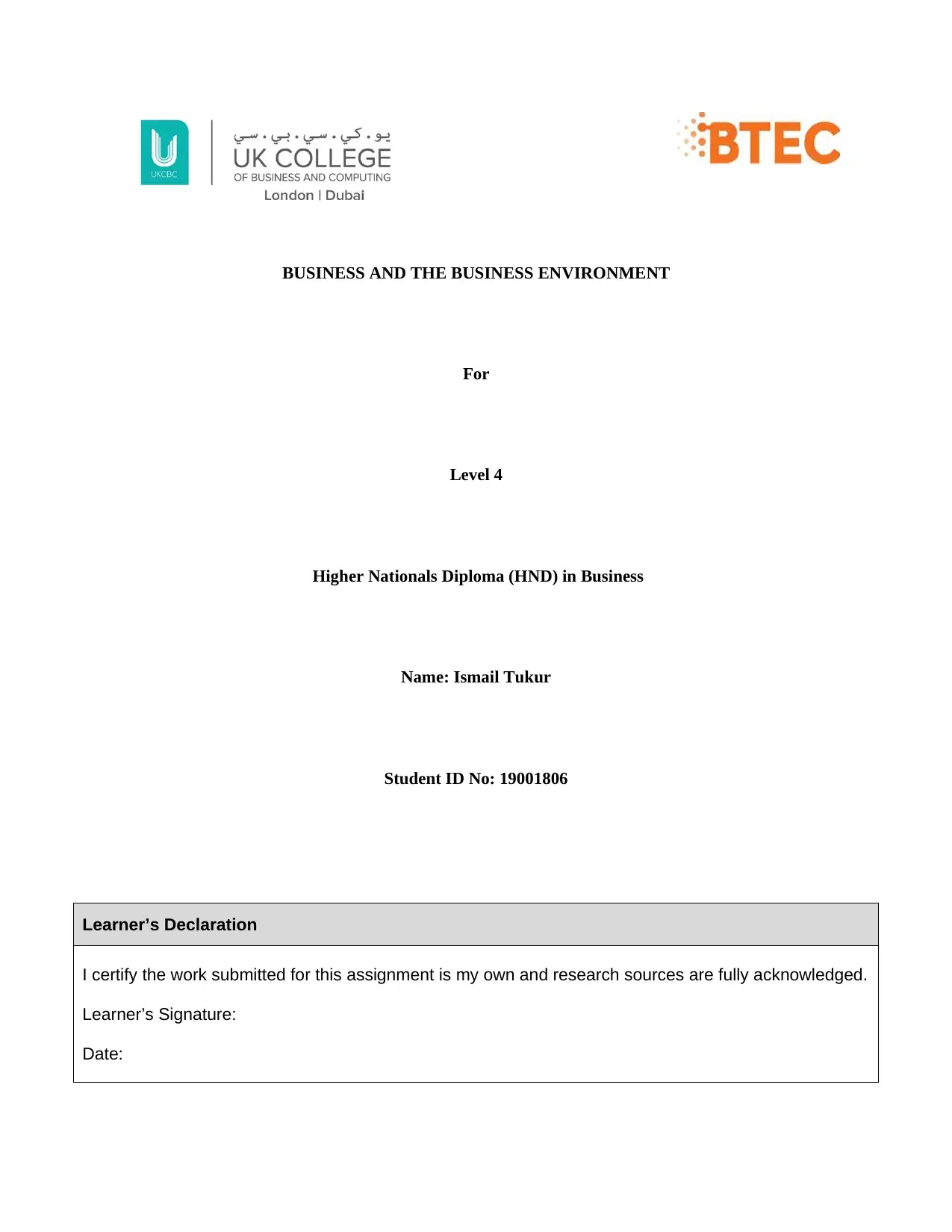
BUSINESS AND THE BUSINESS ENVIRONMENT
For
Level 4
Higher Nationals Diploma (HND) in Business
Name: Ismail Tukur
Student ID No: 19001806
Learner’s Declaration
I certify the work submitted for this assignment is my own and research sources are fully acknowledged.
Learner’s Signature:
Date:
For
Level 4
Higher Nationals Diploma (HND) in Business
Name: Ismail Tukur
Student ID No: 19001806
Learner’s Declaration
I certify the work submitted for this assignment is my own and research sources are fully acknowledged.
Learner’s Signature:
Date:
Paraphrase This Document
Need a fresh take? Get an instant paraphrase of this document with our AI Paraphraser
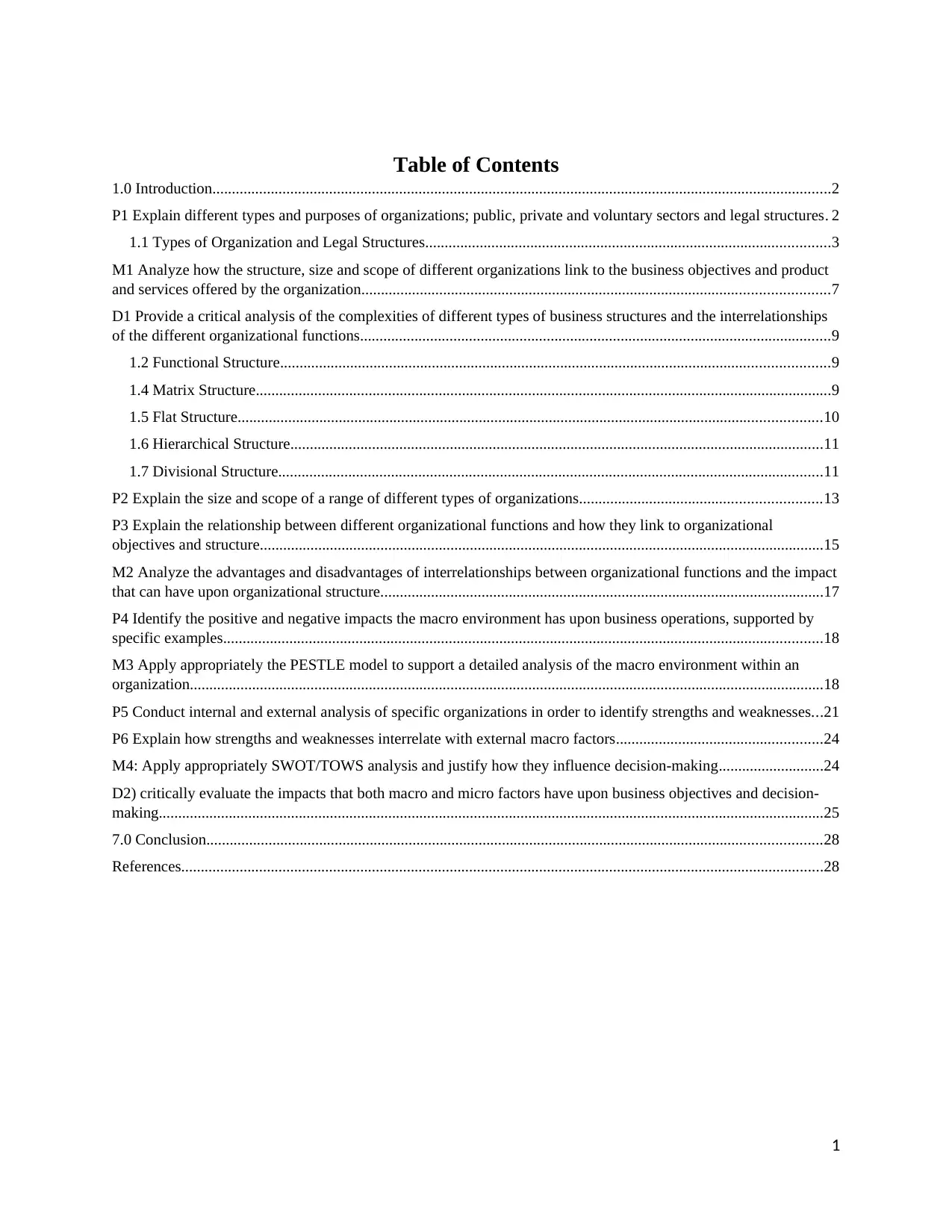
Table of Contents
1.0 Introduction...............................................................................................................................................................2
P1 Explain different types and purposes of organizations; public, private and voluntary sectors and legal structures. 2
1.1 Types of Organization and Legal Structures........................................................................................................3
M1 Analyze how the structure, size and scope of different organizations link to the business objectives and product
and services offered by the organization........................................................................................................................7
D1 Provide a critical analysis of the complexities of different types of business structures and the interrelationships
of the different organizational functions.........................................................................................................................9
1.2 Functional Structure.............................................................................................................................................9
1.4 Matrix Structure....................................................................................................................................................9
1.5 Flat Structure......................................................................................................................................................10
1.6 Hierarchical Structure.........................................................................................................................................11
1.7 Divisional Structure............................................................................................................................................11
P2 Explain the size and scope of a range of different types of organizations..............................................................13
P3 Explain the relationship between different organizational functions and how they link to organizational
objectives and structure.................................................................................................................................................15
M2 Analyze the advantages and disadvantages of interrelationships between organizational functions and the impact
that can have upon organizational structure..................................................................................................................17
P4 Identify the positive and negative impacts the macro environment has upon business operations, supported by
specific examples..........................................................................................................................................................18
M3 Apply appropriately the PESTLE model to support a detailed analysis of the macro environment within an
organization...................................................................................................................................................................18
P5 Conduct internal and external analysis of specific organizations in order to identify strengths and weaknesses...21
P6 Explain how strengths and weaknesses interrelate with external macro factors.....................................................24
M4: Apply appropriately SWOT/TOWS analysis and justify how they influence decision-making...........................24
D2) critically evaluate the impacts that both macro and micro factors have upon business objectives and decision-
making...........................................................................................................................................................................25
7.0 Conclusion..............................................................................................................................................................28
References.....................................................................................................................................................................28
1
1.0 Introduction...............................................................................................................................................................2
P1 Explain different types and purposes of organizations; public, private and voluntary sectors and legal structures. 2
1.1 Types of Organization and Legal Structures........................................................................................................3
M1 Analyze how the structure, size and scope of different organizations link to the business objectives and product
and services offered by the organization........................................................................................................................7
D1 Provide a critical analysis of the complexities of different types of business structures and the interrelationships
of the different organizational functions.........................................................................................................................9
1.2 Functional Structure.............................................................................................................................................9
1.4 Matrix Structure....................................................................................................................................................9
1.5 Flat Structure......................................................................................................................................................10
1.6 Hierarchical Structure.........................................................................................................................................11
1.7 Divisional Structure............................................................................................................................................11
P2 Explain the size and scope of a range of different types of organizations..............................................................13
P3 Explain the relationship between different organizational functions and how they link to organizational
objectives and structure.................................................................................................................................................15
M2 Analyze the advantages and disadvantages of interrelationships between organizational functions and the impact
that can have upon organizational structure..................................................................................................................17
P4 Identify the positive and negative impacts the macro environment has upon business operations, supported by
specific examples..........................................................................................................................................................18
M3 Apply appropriately the PESTLE model to support a detailed analysis of the macro environment within an
organization...................................................................................................................................................................18
P5 Conduct internal and external analysis of specific organizations in order to identify strengths and weaknesses...21
P6 Explain how strengths and weaknesses interrelate with external macro factors.....................................................24
M4: Apply appropriately SWOT/TOWS analysis and justify how they influence decision-making...........................24
D2) critically evaluate the impacts that both macro and micro factors have upon business objectives and decision-
making...........................................................................................................................................................................25
7.0 Conclusion..............................................................................................................................................................28
References.....................................................................................................................................................................28
1
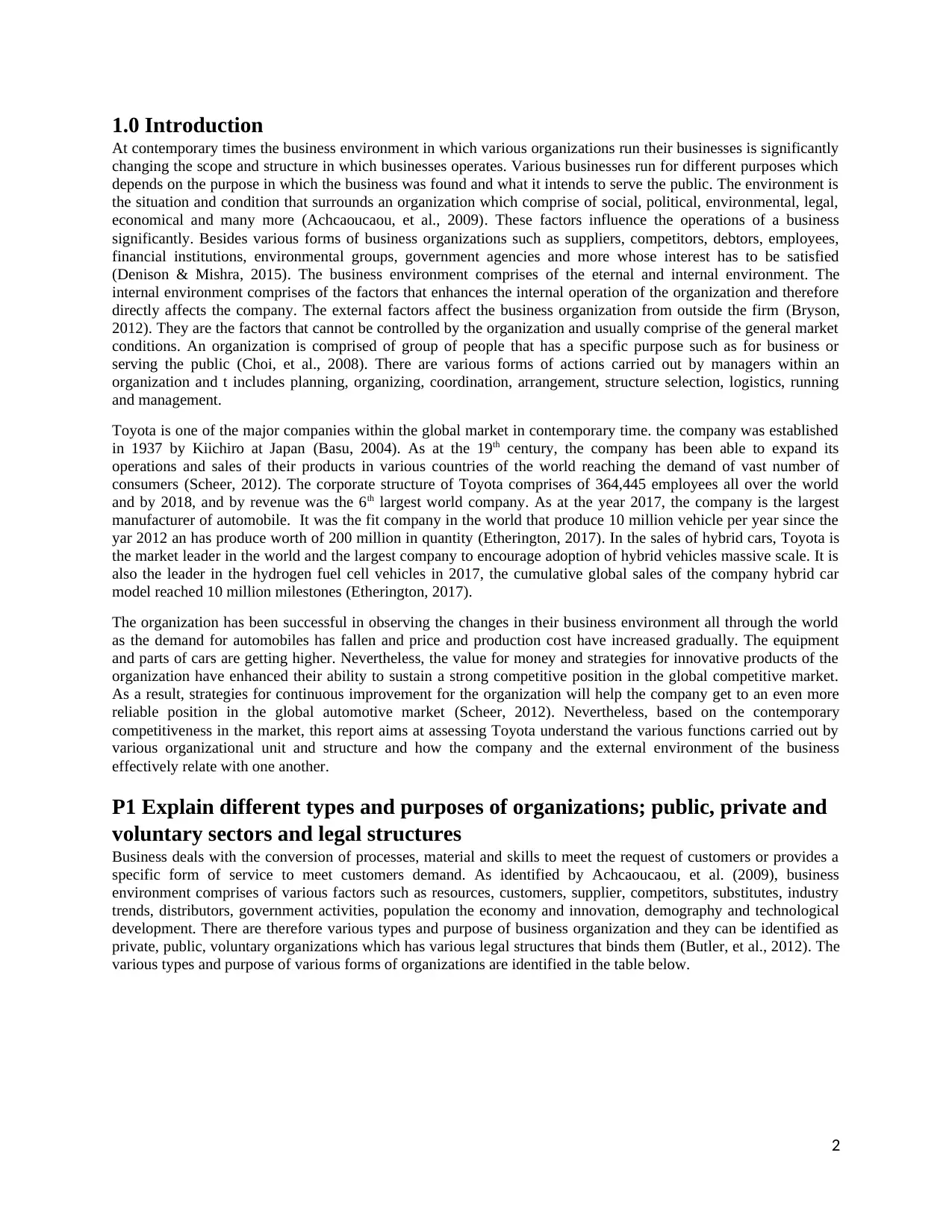
1.0 Introduction
At contemporary times the business environment in which various organizations run their businesses is significantly
changing the scope and structure in which businesses operates. Various businesses run for different purposes which
depends on the purpose in which the business was found and what it intends to serve the public. The environment is
the situation and condition that surrounds an organization which comprise of social, political, environmental, legal,
economical and many more (Achcaoucaou, et al., 2009). These factors influence the operations of a business
significantly. Besides various forms of business organizations such as suppliers, competitors, debtors, employees,
financial institutions, environmental groups, government agencies and more whose interest has to be satisfied
(Denison & Mishra, 2015). The business environment comprises of the eternal and internal environment. The
internal environment comprises of the factors that enhances the internal operation of the organization and therefore
directly affects the company. The external factors affect the business organization from outside the firm (Bryson,
2012). They are the factors that cannot be controlled by the organization and usually comprise of the general market
conditions. An organization is comprised of group of people that has a specific purpose such as for business or
serving the public (Choi, et al., 2008). There are various forms of actions carried out by managers within an
organization and t includes planning, organizing, coordination, arrangement, structure selection, logistics, running
and management.
Toyota is one of the major companies within the global market in contemporary time. the company was established
in 1937 by Kiichiro at Japan (Basu, 2004). As at the 19th century, the company has been able to expand its
operations and sales of their products in various countries of the world reaching the demand of vast number of
consumers (Scheer, 2012). The corporate structure of Toyota comprises of 364,445 employees all over the world
and by 2018, and by revenue was the 6th largest world company. As at the year 2017, the company is the largest
manufacturer of automobile. It was the fit company in the world that produce 10 million vehicle per year since the
yar 2012 an has produce worth of 200 million in quantity (Etherington, 2017). In the sales of hybrid cars, Toyota is
the market leader in the world and the largest company to encourage adoption of hybrid vehicles massive scale. It is
also the leader in the hydrogen fuel cell vehicles in 2017, the cumulative global sales of the company hybrid car
model reached 10 million milestones (Etherington, 2017).
The organization has been successful in observing the changes in their business environment all through the world
as the demand for automobiles has fallen and price and production cost have increased gradually. The equipment
and parts of cars are getting higher. Nevertheless, the value for money and strategies for innovative products of the
organization have enhanced their ability to sustain a strong competitive position in the global competitive market.
As a result, strategies for continuous improvement for the organization will help the company get to an even more
reliable position in the global automotive market (Scheer, 2012). Nevertheless, based on the contemporary
competitiveness in the market, this report aims at assessing Toyota understand the various functions carried out by
various organizational unit and structure and how the company and the external environment of the business
effectively relate with one another.
P1 Explain different types and purposes of organizations; public, private and
voluntary sectors and legal structures
Business deals with the conversion of processes, material and skills to meet the request of customers or provides a
specific form of service to meet customers demand. As identified by Achcaoucaou, et al. (2009), business
environment comprises of various factors such as resources, customers, supplier, competitors, substitutes, industry
trends, distributors, government activities, population the economy and innovation, demography and technological
development. There are therefore various types and purpose of business organization and they can be identified as
private, public, voluntary organizations which has various legal structures that binds them (Butler, et al., 2012). The
various types and purpose of various forms of organizations are identified in the table below.
2
At contemporary times the business environment in which various organizations run their businesses is significantly
changing the scope and structure in which businesses operates. Various businesses run for different purposes which
depends on the purpose in which the business was found and what it intends to serve the public. The environment is
the situation and condition that surrounds an organization which comprise of social, political, environmental, legal,
economical and many more (Achcaoucaou, et al., 2009). These factors influence the operations of a business
significantly. Besides various forms of business organizations such as suppliers, competitors, debtors, employees,
financial institutions, environmental groups, government agencies and more whose interest has to be satisfied
(Denison & Mishra, 2015). The business environment comprises of the eternal and internal environment. The
internal environment comprises of the factors that enhances the internal operation of the organization and therefore
directly affects the company. The external factors affect the business organization from outside the firm (Bryson,
2012). They are the factors that cannot be controlled by the organization and usually comprise of the general market
conditions. An organization is comprised of group of people that has a specific purpose such as for business or
serving the public (Choi, et al., 2008). There are various forms of actions carried out by managers within an
organization and t includes planning, organizing, coordination, arrangement, structure selection, logistics, running
and management.
Toyota is one of the major companies within the global market in contemporary time. the company was established
in 1937 by Kiichiro at Japan (Basu, 2004). As at the 19th century, the company has been able to expand its
operations and sales of their products in various countries of the world reaching the demand of vast number of
consumers (Scheer, 2012). The corporate structure of Toyota comprises of 364,445 employees all over the world
and by 2018, and by revenue was the 6th largest world company. As at the year 2017, the company is the largest
manufacturer of automobile. It was the fit company in the world that produce 10 million vehicle per year since the
yar 2012 an has produce worth of 200 million in quantity (Etherington, 2017). In the sales of hybrid cars, Toyota is
the market leader in the world and the largest company to encourage adoption of hybrid vehicles massive scale. It is
also the leader in the hydrogen fuel cell vehicles in 2017, the cumulative global sales of the company hybrid car
model reached 10 million milestones (Etherington, 2017).
The organization has been successful in observing the changes in their business environment all through the world
as the demand for automobiles has fallen and price and production cost have increased gradually. The equipment
and parts of cars are getting higher. Nevertheless, the value for money and strategies for innovative products of the
organization have enhanced their ability to sustain a strong competitive position in the global competitive market.
As a result, strategies for continuous improvement for the organization will help the company get to an even more
reliable position in the global automotive market (Scheer, 2012). Nevertheless, based on the contemporary
competitiveness in the market, this report aims at assessing Toyota understand the various functions carried out by
various organizational unit and structure and how the company and the external environment of the business
effectively relate with one another.
P1 Explain different types and purposes of organizations; public, private and
voluntary sectors and legal structures
Business deals with the conversion of processes, material and skills to meet the request of customers or provides a
specific form of service to meet customers demand. As identified by Achcaoucaou, et al. (2009), business
environment comprises of various factors such as resources, customers, supplier, competitors, substitutes, industry
trends, distributors, government activities, population the economy and innovation, demography and technological
development. There are therefore various types and purpose of business organization and they can be identified as
private, public, voluntary organizations which has various legal structures that binds them (Butler, et al., 2012). The
various types and purpose of various forms of organizations are identified in the table below.
2
⊘ This is a preview!⊘
Do you want full access?
Subscribe today to unlock all pages.

Trusted by 1+ million students worldwide
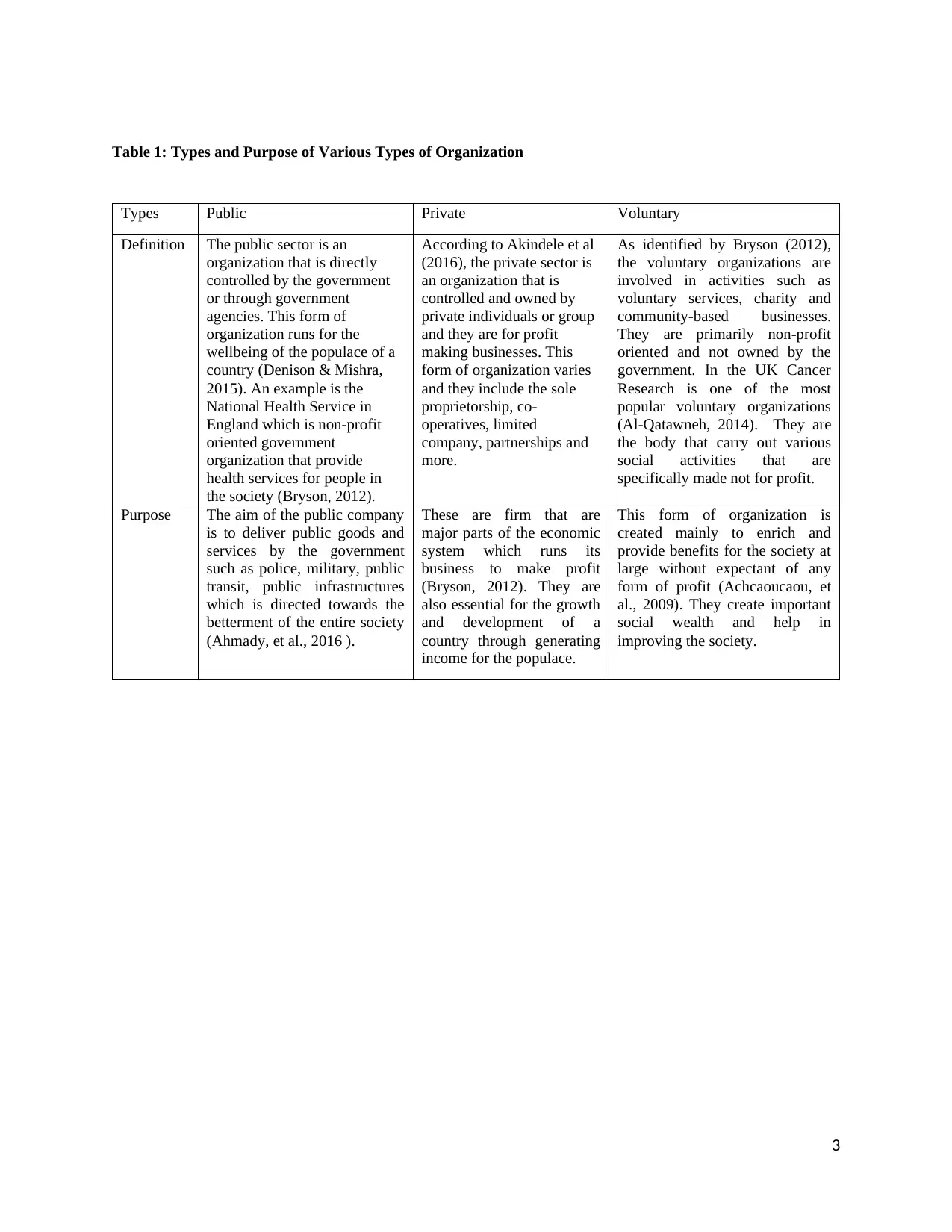
Table 1: Types and Purpose of Various Types of Organization
Types Public Private Voluntary
Definition The public sector is an
organization that is directly
controlled by the government
or through government
agencies. This form of
organization runs for the
wellbeing of the populace of a
country (Denison & Mishra,
2015). An example is the
National Health Service in
England which is non-profit
oriented government
organization that provide
health services for people in
the society (Bryson, 2012).
According to Akindele et al
(2016), the private sector is
an organization that is
controlled and owned by
private individuals or group
and they are for profit
making businesses. This
form of organization varies
and they include the sole
proprietorship, co-
operatives, limited
company, partnerships and
more.
As identified by Bryson (2012),
the voluntary organizations are
involved in activities such as
voluntary services, charity and
community-based businesses.
They are primarily non-profit
oriented and not owned by the
government. In the UK Cancer
Research is one of the most
popular voluntary organizations
(Al-Qatawneh, 2014). They are
the body that carry out various
social activities that are
specifically made not for profit.
Purpose The aim of the public company
is to deliver public goods and
services by the government
such as police, military, public
transit, public infrastructures
which is directed towards the
betterment of the entire society
(Ahmady, et al., 2016 ).
These are firm that are
major parts of the economic
system which runs its
business to make profit
(Bryson, 2012). They are
also essential for the growth
and development of a
country through generating
income for the populace.
This form of organization is
created mainly to enrich and
provide benefits for the society at
large without expectant of any
form of profit (Achcaoucaou, et
al., 2009). They create important
social wealth and help in
improving the society.
3
Types Public Private Voluntary
Definition The public sector is an
organization that is directly
controlled by the government
or through government
agencies. This form of
organization runs for the
wellbeing of the populace of a
country (Denison & Mishra,
2015). An example is the
National Health Service in
England which is non-profit
oriented government
organization that provide
health services for people in
the society (Bryson, 2012).
According to Akindele et al
(2016), the private sector is
an organization that is
controlled and owned by
private individuals or group
and they are for profit
making businesses. This
form of organization varies
and they include the sole
proprietorship, co-
operatives, limited
company, partnerships and
more.
As identified by Bryson (2012),
the voluntary organizations are
involved in activities such as
voluntary services, charity and
community-based businesses.
They are primarily non-profit
oriented and not owned by the
government. In the UK Cancer
Research is one of the most
popular voluntary organizations
(Al-Qatawneh, 2014). They are
the body that carry out various
social activities that are
specifically made not for profit.
Purpose The aim of the public company
is to deliver public goods and
services by the government
such as police, military, public
transit, public infrastructures
which is directed towards the
betterment of the entire society
(Ahmady, et al., 2016 ).
These are firm that are
major parts of the economic
system which runs its
business to make profit
(Bryson, 2012). They are
also essential for the growth
and development of a
country through generating
income for the populace.
This form of organization is
created mainly to enrich and
provide benefits for the society at
large without expectant of any
form of profit (Achcaoucaou, et
al., 2009). They create important
social wealth and help in
improving the society.
3
Paraphrase This Document
Need a fresh take? Get an instant paraphrase of this document with our AI Paraphraser
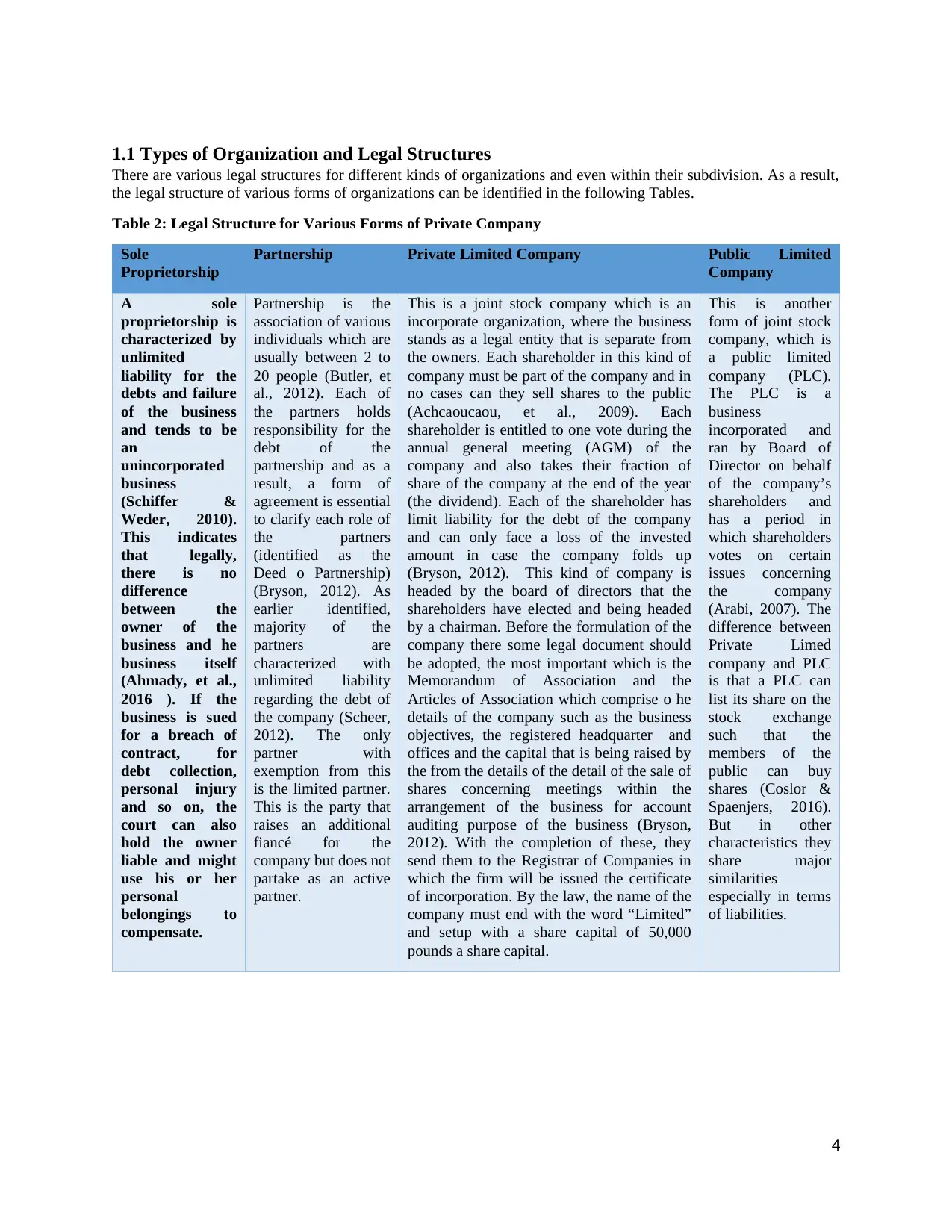
1.1 Types of Organization and Legal Structures
There are various legal structures for different kinds of organizations and even within their subdivision. As a result,
the legal structure of various forms of organizations can be identified in the following Tables.
Table 2: Legal Structure for Various Forms of Private Company
Sole
Proprietorship
Partnership Private Limited Company Public Limited
Company
A sole
proprietorship is
characterized by
unlimited
liability for the
debts and failure
of the business
and tends to be
an
unincorporated
business
(Schiffer &
Weder, 2010).
This indicates
that legally,
there is no
difference
between the
owner of the
business and he
business itself
(Ahmady, et al.,
2016 ). If the
business is sued
for a breach of
contract, for
debt collection,
personal injury
and so on, the
court can also
hold the owner
liable and might
use his or her
personal
belongings to
compensate.
Partnership is the
association of various
individuals which are
usually between 2 to
20 people (Butler, et
al., 2012). Each of
the partners holds
responsibility for the
debt of the
partnership and as a
result, a form of
agreement is essential
to clarify each role of
the partners
(identified as the
Deed o Partnership)
(Bryson, 2012). As
earlier identified,
majority of the
partners are
characterized with
unlimited liability
regarding the debt of
the company (Scheer,
2012). The only
partner with
exemption from this
is the limited partner.
This is the party that
raises an additional
fiancé for the
company but does not
partake as an active
partner.
This is a joint stock company which is an
incorporate organization, where the business
stands as a legal entity that is separate from
the owners. Each shareholder in this kind of
company must be part of the company and in
no cases can they sell shares to the public
(Achcaoucaou, et al., 2009). Each
shareholder is entitled to one vote during the
annual general meeting (AGM) of the
company and also takes their fraction of
share of the company at the end of the year
(the dividend). Each of the shareholder has
limit liability for the debt of the company
and can only face a loss of the invested
amount in case the company folds up
(Bryson, 2012). This kind of company is
headed by the board of directors that the
shareholders have elected and being headed
by a chairman. Before the formulation of the
company there some legal document should
be adopted, the most important which is the
Memorandum of Association and the
Articles of Association which comprise o he
details of the company such as the business
objectives, the registered headquarter and
offices and the capital that is being raised by
the from the details of the detail of the sale of
shares concerning meetings within the
arrangement of the business for account
auditing purpose of the business (Bryson,
2012). With the completion of these, they
send them to the Registrar of Companies in
which the firm will be issued the certificate
of incorporation. By the law, the name of the
company must end with the word “Limited”
and setup with a share capital of 50,000
pounds a share capital.
This is another
form of joint stock
company, which is
a public limited
company (PLC).
The PLC is a
business
incorporated and
ran by Board of
Director on behalf
of the company’s
shareholders and
has a period in
which shareholders
votes on certain
issues concerning
the company
(Arabi, 2007). The
difference between
Private Limed
company and PLC
is that a PLC can
list its share on the
stock exchange
such that the
members of the
public can buy
shares (Coslor &
Spaenjers, 2016).
But in other
characteristics they
share major
similarities
especially in terms
of liabilities.
4
There are various legal structures for different kinds of organizations and even within their subdivision. As a result,
the legal structure of various forms of organizations can be identified in the following Tables.
Table 2: Legal Structure for Various Forms of Private Company
Sole
Proprietorship
Partnership Private Limited Company Public Limited
Company
A sole
proprietorship is
characterized by
unlimited
liability for the
debts and failure
of the business
and tends to be
an
unincorporated
business
(Schiffer &
Weder, 2010).
This indicates
that legally,
there is no
difference
between the
owner of the
business and he
business itself
(Ahmady, et al.,
2016 ). If the
business is sued
for a breach of
contract, for
debt collection,
personal injury
and so on, the
court can also
hold the owner
liable and might
use his or her
personal
belongings to
compensate.
Partnership is the
association of various
individuals which are
usually between 2 to
20 people (Butler, et
al., 2012). Each of
the partners holds
responsibility for the
debt of the
partnership and as a
result, a form of
agreement is essential
to clarify each role of
the partners
(identified as the
Deed o Partnership)
(Bryson, 2012). As
earlier identified,
majority of the
partners are
characterized with
unlimited liability
regarding the debt of
the company (Scheer,
2012). The only
partner with
exemption from this
is the limited partner.
This is the party that
raises an additional
fiancé for the
company but does not
partake as an active
partner.
This is a joint stock company which is an
incorporate organization, where the business
stands as a legal entity that is separate from
the owners. Each shareholder in this kind of
company must be part of the company and in
no cases can they sell shares to the public
(Achcaoucaou, et al., 2009). Each
shareholder is entitled to one vote during the
annual general meeting (AGM) of the
company and also takes their fraction of
share of the company at the end of the year
(the dividend). Each of the shareholder has
limit liability for the debt of the company
and can only face a loss of the invested
amount in case the company folds up
(Bryson, 2012). This kind of company is
headed by the board of directors that the
shareholders have elected and being headed
by a chairman. Before the formulation of the
company there some legal document should
be adopted, the most important which is the
Memorandum of Association and the
Articles of Association which comprise o he
details of the company such as the business
objectives, the registered headquarter and
offices and the capital that is being raised by
the from the details of the detail of the sale of
shares concerning meetings within the
arrangement of the business for account
auditing purpose of the business (Bryson,
2012). With the completion of these, they
send them to the Registrar of Companies in
which the firm will be issued the certificate
of incorporation. By the law, the name of the
company must end with the word “Limited”
and setup with a share capital of 50,000
pounds a share capital.
This is another
form of joint stock
company, which is
a public limited
company (PLC).
The PLC is a
business
incorporated and
ran by Board of
Director on behalf
of the company’s
shareholders and
has a period in
which shareholders
votes on certain
issues concerning
the company
(Arabi, 2007). The
difference between
Private Limed
company and PLC
is that a PLC can
list its share on the
stock exchange
such that the
members of the
public can buy
shares (Coslor &
Spaenjers, 2016).
But in other
characteristics they
share major
similarities
especially in terms
of liabilities.
4

Table 3: Legal Structure for Various Forms of Public Company
Public Sector Organizations
The public sector organizations refer to the companies that are accountable to the government whether
centrally or locally. They are directly funded by the government and tend and are used for providing
government goods and services and are not profit making oriented (Atinc, et al., 2010). The public sector
produces three kids of goods which includes (Bryson, 2012):
1. The public goods that cannot be easily provided by private organizations, as a result of the venture not
being profitable but essential or the populace (such as armed forces and emergency)
2. Merit goods are the goods in which the government believe that everyone has to possess whether they
have the capability of possessing it or not (such as healthcare and education).
3. Essential services include, parks, libraries, roads, reuse collection, street cleaning and many more.
A public corporation is the term used in describing an industry that is nationalized for the provision of goods and
services for the general public. Public goods, merit goods and essential services are funded by the government
through taxes and are liable for the provision of essential services to the people
Table 4: Legal Structure for Various Forms of Voluntary Organization
Unincorporated
Association
Trust Company Limited by
Guarantee
Charitable Incorporated
Organization (CIO)
This structure is usually
adopted by small
associations built for a
short-term goal, low
income, without intention
to acquire property or
employ staff (Al-Qatawneh,
2014). Unincorporated
associations are very quick
and affordable to setup.
Unless this group applies
for being a charitable
organization, it needs no
other agencies to be
involved in its activities.
They do not make any fee
payment except for getting
legal advice (Achcaoucaou,
et al., 2009). Nevertheless,
legally, the owner or
founders of unincorporated
association do not have a
separate legal identity and
remains for the purpose in
regards to the collection of
individuals. Any form of
contract or property is held
by an individual for the rest
of the group members, or
any form of legal
proceeding legal position
filled against the entire
group is filled against the
individuals within it which
In general, trusts are
created to manage
property or money
towards a clearly
defined objective and
goals (Ahmady, et
al., 2016). They are
the basis of a formal
relationship between
three parties which
includes the donor of
the property or
money, the trustees
which are usually
three and are the
nominal owners of
the property of the
trust and the
beneficiaries. Trust
can be fast to setup
and significantly
affordable (Bryson,
2012). Mainly, they
are nondemocratic
organizations as they
have no legal
structure for
membership. The
trustees can be liable
personally for the
contract the trust
enters into and are
not protected from
being personally
This tend to be one of
the most common
voluntary organization.
They are limited liability
organizations, registered
at the Companies House
and incorporated
(Ahmady, et al., 2016 ).
The article of association
governs the activities of
the group. It is on its
own a legal entity and
therefore could hold
properties and enter into
contact in its name. This
is a well-recognized
structure and it being of
limited liability provides
its members with a
certain level of
protection (Butler, et al.,
2012). One of the
disadvantages of this is
within the expense and
formality that might
arise as being a limited
liability company. The
filings have to be
submitted to the Charity
Commission and the
Company House. The
trustee is also
responsible for the duties
their trustee duties and
The CIO is the most recent
legal form for a charity
organization as it is
designed specifically for
such purpose
(Achcaoucaou, et al., 2009).
The Charity Commission
solely regulate them and
therefore avoids the need for
filings compared to the
limited liability company.
The activities of the
organization are governed
by a constitution which is
given by the Charity
Commission and does not
have much flexibility as the
unincorporated association
or the trust. The benefit of a
CIO arises due to the fact
that its members are able to
possess limited liabilities
and the association having
its own legal identity
providing a level of
protection for members
(Arabi, 2007). The negative
aspect of this structure is
that it is relatively untried
and new which could bring
about potential problems in
the process of seeking
finance from financial
bodies which maybe not be
5
Public Sector Organizations
The public sector organizations refer to the companies that are accountable to the government whether
centrally or locally. They are directly funded by the government and tend and are used for providing
government goods and services and are not profit making oriented (Atinc, et al., 2010). The public sector
produces three kids of goods which includes (Bryson, 2012):
1. The public goods that cannot be easily provided by private organizations, as a result of the venture not
being profitable but essential or the populace (such as armed forces and emergency)
2. Merit goods are the goods in which the government believe that everyone has to possess whether they
have the capability of possessing it or not (such as healthcare and education).
3. Essential services include, parks, libraries, roads, reuse collection, street cleaning and many more.
A public corporation is the term used in describing an industry that is nationalized for the provision of goods and
services for the general public. Public goods, merit goods and essential services are funded by the government
through taxes and are liable for the provision of essential services to the people
Table 4: Legal Structure for Various Forms of Voluntary Organization
Unincorporated
Association
Trust Company Limited by
Guarantee
Charitable Incorporated
Organization (CIO)
This structure is usually
adopted by small
associations built for a
short-term goal, low
income, without intention
to acquire property or
employ staff (Al-Qatawneh,
2014). Unincorporated
associations are very quick
and affordable to setup.
Unless this group applies
for being a charitable
organization, it needs no
other agencies to be
involved in its activities.
They do not make any fee
payment except for getting
legal advice (Achcaoucaou,
et al., 2009). Nevertheless,
legally, the owner or
founders of unincorporated
association do not have a
separate legal identity and
remains for the purpose in
regards to the collection of
individuals. Any form of
contract or property is held
by an individual for the rest
of the group members, or
any form of legal
proceeding legal position
filled against the entire
group is filled against the
individuals within it which
In general, trusts are
created to manage
property or money
towards a clearly
defined objective and
goals (Ahmady, et
al., 2016). They are
the basis of a formal
relationship between
three parties which
includes the donor of
the property or
money, the trustees
which are usually
three and are the
nominal owners of
the property of the
trust and the
beneficiaries. Trust
can be fast to setup
and significantly
affordable (Bryson,
2012). Mainly, they
are nondemocratic
organizations as they
have no legal
structure for
membership. The
trustees can be liable
personally for the
contract the trust
enters into and are
not protected from
being personally
This tend to be one of
the most common
voluntary organization.
They are limited liability
organizations, registered
at the Companies House
and incorporated
(Ahmady, et al., 2016 ).
The article of association
governs the activities of
the group. It is on its
own a legal entity and
therefore could hold
properties and enter into
contact in its name. This
is a well-recognized
structure and it being of
limited liability provides
its members with a
certain level of
protection (Butler, et al.,
2012). One of the
disadvantages of this is
within the expense and
formality that might
arise as being a limited
liability company. The
filings have to be
submitted to the Charity
Commission and the
Company House. The
trustee is also
responsible for the duties
their trustee duties and
The CIO is the most recent
legal form for a charity
organization as it is
designed specifically for
such purpose
(Achcaoucaou, et al., 2009).
The Charity Commission
solely regulate them and
therefore avoids the need for
filings compared to the
limited liability company.
The activities of the
organization are governed
by a constitution which is
given by the Charity
Commission and does not
have much flexibility as the
unincorporated association
or the trust. The benefit of a
CIO arises due to the fact
that its members are able to
possess limited liabilities
and the association having
its own legal identity
providing a level of
protection for members
(Arabi, 2007). The negative
aspect of this structure is
that it is relatively untried
and new which could bring
about potential problems in
the process of seeking
finance from financial
bodies which maybe not be
5
⊘ This is a preview!⊘
Do you want full access?
Subscribe today to unlock all pages.

Trusted by 1+ million students worldwide
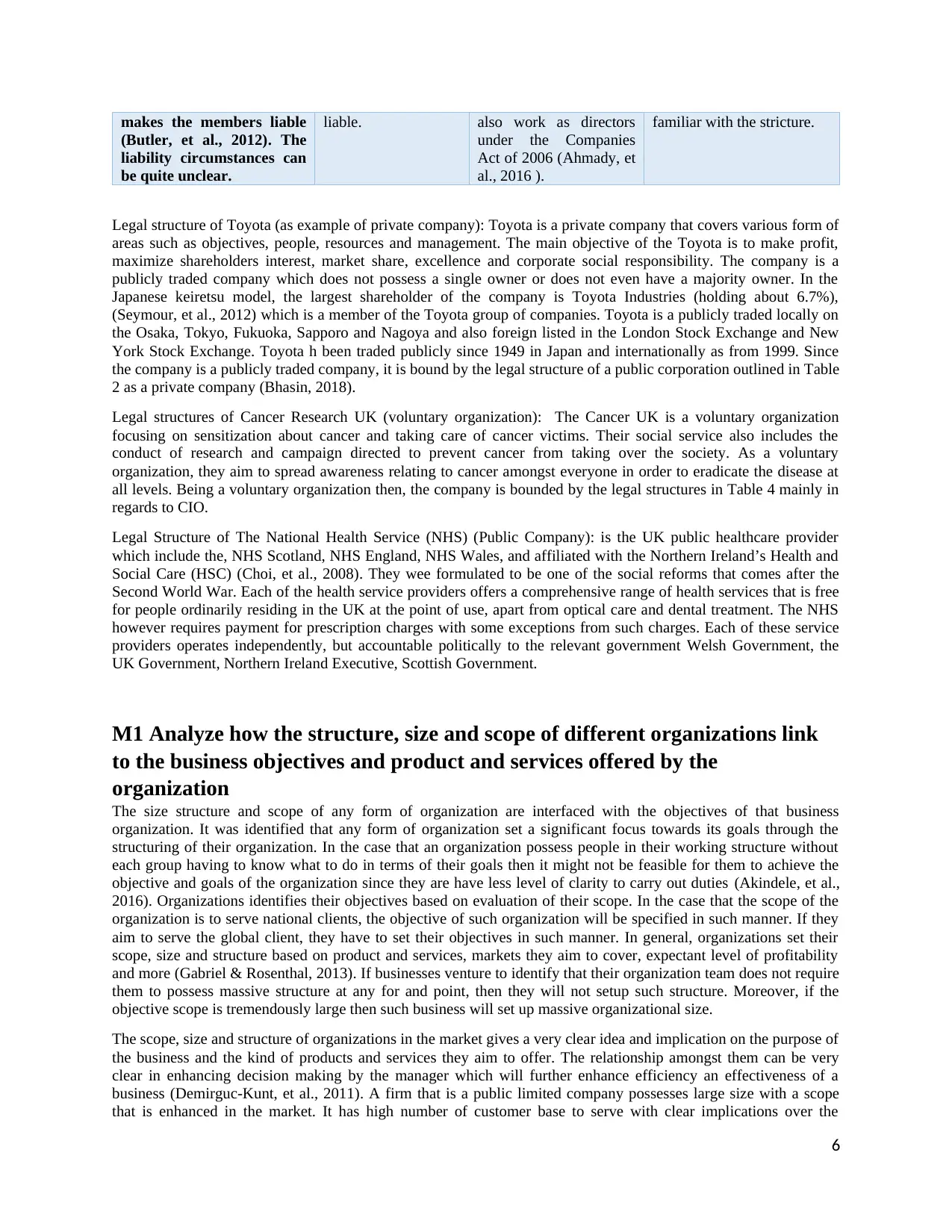
makes the members liable
(Butler, et al., 2012). The
liability circumstances can
be quite unclear.
liable. also work as directors
under the Companies
Act of 2006 (Ahmady, et
al., 2016 ).
familiar with the stricture.
Legal structure of Toyota (as example of private company): Toyota is a private company that covers various form of
areas such as objectives, people, resources and management. The main objective of the Toyota is to make profit,
maximize shareholders interest, market share, excellence and corporate social responsibility. The company is a
publicly traded company which does not possess a single owner or does not even have a majority owner. In the
Japanese keiretsu model, the largest shareholder of the company is Toyota Industries (holding about 6.7%),
(Seymour, et al., 2012) which is a member of the Toyota group of companies. Toyota is a publicly traded locally on
the Osaka, Tokyo, Fukuoka, Sapporo and Nagoya and also foreign listed in the London Stock Exchange and New
York Stock Exchange. Toyota h been traded publicly since 1949 in Japan and internationally as from 1999. Since
the company is a publicly traded company, it is bound by the legal structure of a public corporation outlined in Table
2 as a private company (Bhasin, 2018).
Legal structures of Cancer Research UK (voluntary organization): The Cancer UK is a voluntary organization
focusing on sensitization about cancer and taking care of cancer victims. Their social service also includes the
conduct of research and campaign directed to prevent cancer from taking over the society. As a voluntary
organization, they aim to spread awareness relating to cancer amongst everyone in order to eradicate the disease at
all levels. Being a voluntary organization then, the company is bounded by the legal structures in Table 4 mainly in
regards to CIO.
Legal Structure of The National Health Service (NHS) (Public Company): is the UK public healthcare provider
which include the, NHS Scotland, NHS England, NHS Wales, and affiliated with the Northern Ireland’s Health and
Social Care (HSC) (Choi, et al., 2008). They wee formulated to be one of the social reforms that comes after the
Second World War. Each of the health service providers offers a comprehensive range of health services that is free
for people ordinarily residing in the UK at the point of use, apart from optical care and dental treatment. The NHS
however requires payment for prescription charges with some exceptions from such charges. Each of these service
providers operates independently, but accountable politically to the relevant government Welsh Government, the
UK Government, Northern Ireland Executive, Scottish Government.
M1 Analyze how the structure, size and scope of different organizations link
to the business objectives and product and services offered by the
organization
The size structure and scope of any form of organization are interfaced with the objectives of that business
organization. It was identified that any form of organization set a significant focus towards its goals through the
structuring of their organization. In the case that an organization possess people in their working structure without
each group having to know what to do in terms of their goals then it might not be feasible for them to achieve the
objective and goals of the organization since they are have less level of clarity to carry out duties (Akindele, et al.,
2016). Organizations identifies their objectives based on evaluation of their scope. In the case that the scope of the
organization is to serve national clients, the objective of such organization will be specified in such manner. If they
aim to serve the global client, they have to set their objectives in such manner. In general, organizations set their
scope, size and structure based on product and services, markets they aim to cover, expectant level of profitability
and more (Gabriel & Rosenthal, 2013). If businesses venture to identify that their organization team does not require
them to possess massive structure at any for and point, then they will not setup such structure. Moreover, if the
objective scope is tremendously large then such business will set up massive organizational size.
The scope, size and structure of organizations in the market gives a very clear idea and implication on the purpose of
the business and the kind of products and services they aim to offer. The relationship amongst them can be very
clear in enhancing decision making by the manager which will further enhance efficiency an effectiveness of a
business (Demirguc-Kunt, et al., 2011). A firm that is a public limited company possesses large size with a scope
that is enhanced in the market. It has high number of customer base to serve with clear implications over the
6
(Butler, et al., 2012). The
liability circumstances can
be quite unclear.
liable. also work as directors
under the Companies
Act of 2006 (Ahmady, et
al., 2016 ).
familiar with the stricture.
Legal structure of Toyota (as example of private company): Toyota is a private company that covers various form of
areas such as objectives, people, resources and management. The main objective of the Toyota is to make profit,
maximize shareholders interest, market share, excellence and corporate social responsibility. The company is a
publicly traded company which does not possess a single owner or does not even have a majority owner. In the
Japanese keiretsu model, the largest shareholder of the company is Toyota Industries (holding about 6.7%),
(Seymour, et al., 2012) which is a member of the Toyota group of companies. Toyota is a publicly traded locally on
the Osaka, Tokyo, Fukuoka, Sapporo and Nagoya and also foreign listed in the London Stock Exchange and New
York Stock Exchange. Toyota h been traded publicly since 1949 in Japan and internationally as from 1999. Since
the company is a publicly traded company, it is bound by the legal structure of a public corporation outlined in Table
2 as a private company (Bhasin, 2018).
Legal structures of Cancer Research UK (voluntary organization): The Cancer UK is a voluntary organization
focusing on sensitization about cancer and taking care of cancer victims. Their social service also includes the
conduct of research and campaign directed to prevent cancer from taking over the society. As a voluntary
organization, they aim to spread awareness relating to cancer amongst everyone in order to eradicate the disease at
all levels. Being a voluntary organization then, the company is bounded by the legal structures in Table 4 mainly in
regards to CIO.
Legal Structure of The National Health Service (NHS) (Public Company): is the UK public healthcare provider
which include the, NHS Scotland, NHS England, NHS Wales, and affiliated with the Northern Ireland’s Health and
Social Care (HSC) (Choi, et al., 2008). They wee formulated to be one of the social reforms that comes after the
Second World War. Each of the health service providers offers a comprehensive range of health services that is free
for people ordinarily residing in the UK at the point of use, apart from optical care and dental treatment. The NHS
however requires payment for prescription charges with some exceptions from such charges. Each of these service
providers operates independently, but accountable politically to the relevant government Welsh Government, the
UK Government, Northern Ireland Executive, Scottish Government.
M1 Analyze how the structure, size and scope of different organizations link
to the business objectives and product and services offered by the
organization
The size structure and scope of any form of organization are interfaced with the objectives of that business
organization. It was identified that any form of organization set a significant focus towards its goals through the
structuring of their organization. In the case that an organization possess people in their working structure without
each group having to know what to do in terms of their goals then it might not be feasible for them to achieve the
objective and goals of the organization since they are have less level of clarity to carry out duties (Akindele, et al.,
2016). Organizations identifies their objectives based on evaluation of their scope. In the case that the scope of the
organization is to serve national clients, the objective of such organization will be specified in such manner. If they
aim to serve the global client, they have to set their objectives in such manner. In general, organizations set their
scope, size and structure based on product and services, markets they aim to cover, expectant level of profitability
and more (Gabriel & Rosenthal, 2013). If businesses venture to identify that their organization team does not require
them to possess massive structure at any for and point, then they will not setup such structure. Moreover, if the
objective scope is tremendously large then such business will set up massive organizational size.
The scope, size and structure of organizations in the market gives a very clear idea and implication on the purpose of
the business and the kind of products and services they aim to offer. The relationship amongst them can be very
clear in enhancing decision making by the manager which will further enhance efficiency an effectiveness of a
business (Demirguc-Kunt, et al., 2011). A firm that is a public limited company possesses large size with a scope
that is enhanced in the market. It has high number of customer base to serve with clear implications over the
6
Paraphrase This Document
Need a fresh take? Get an instant paraphrase of this document with our AI Paraphraser
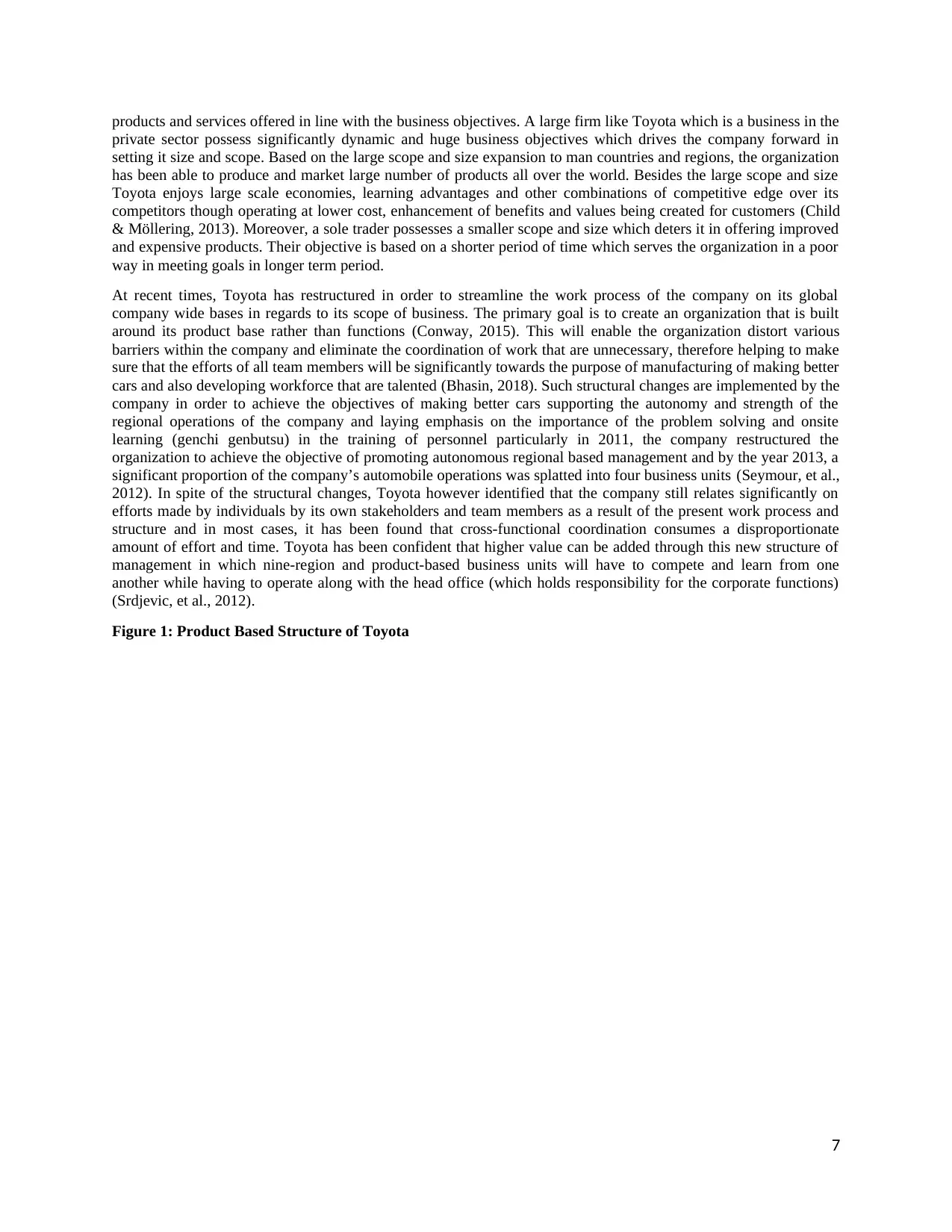
products and services offered in line with the business objectives. A large firm like Toyota which is a business in the
private sector possess significantly dynamic and huge business objectives which drives the company forward in
setting it size and scope. Based on the large scope and size expansion to man countries and regions, the organization
has been able to produce and market large number of products all over the world. Besides the large scope and size
Toyota enjoys large scale economies, learning advantages and other combinations of competitive edge over its
competitors though operating at lower cost, enhancement of benefits and values being created for customers (Child
& Möllering, 2013). Moreover, a sole trader possesses a smaller scope and size which deters it in offering improved
and expensive products. Their objective is based on a shorter period of time which serves the organization in a poor
way in meeting goals in longer term period.
At recent times, Toyota has restructured in order to streamline the work process of the company on its global
company wide bases in regards to its scope of business. The primary goal is to create an organization that is built
around its product base rather than functions (Conway, 2015). This will enable the organization distort various
barriers within the company and eliminate the coordination of work that are unnecessary, therefore helping to make
sure that the efforts of all team members will be significantly towards the purpose of manufacturing of making better
cars and also developing workforce that are talented (Bhasin, 2018). Such structural changes are implemented by the
company in order to achieve the objectives of making better cars supporting the autonomy and strength of the
regional operations of the company and laying emphasis on the importance of the problem solving and onsite
learning (genchi genbutsu) in the training of personnel particularly in 2011, the company restructured the
organization to achieve the objective of promoting autonomous regional based management and by the year 2013, a
significant proportion of the company’s automobile operations was splatted into four business units (Seymour, et al.,
2012). In spite of the structural changes, Toyota however identified that the company still relates significantly on
efforts made by individuals by its own stakeholders and team members as a result of the present work process and
structure and in most cases, it has been found that cross-functional coordination consumes a disproportionate
amount of effort and time. Toyota has been confident that higher value can be added through this new structure of
management in which nine-region and product-based business units will have to compete and learn from one
another while having to operate along with the head office (which holds responsibility for the corporate functions)
(Srdjevic, et al., 2012).
Figure 1: Product Based Structure of Toyota
7
private sector possess significantly dynamic and huge business objectives which drives the company forward in
setting it size and scope. Based on the large scope and size expansion to man countries and regions, the organization
has been able to produce and market large number of products all over the world. Besides the large scope and size
Toyota enjoys large scale economies, learning advantages and other combinations of competitive edge over its
competitors though operating at lower cost, enhancement of benefits and values being created for customers (Child
& Möllering, 2013). Moreover, a sole trader possesses a smaller scope and size which deters it in offering improved
and expensive products. Their objective is based on a shorter period of time which serves the organization in a poor
way in meeting goals in longer term period.
At recent times, Toyota has restructured in order to streamline the work process of the company on its global
company wide bases in regards to its scope of business. The primary goal is to create an organization that is built
around its product base rather than functions (Conway, 2015). This will enable the organization distort various
barriers within the company and eliminate the coordination of work that are unnecessary, therefore helping to make
sure that the efforts of all team members will be significantly towards the purpose of manufacturing of making better
cars and also developing workforce that are talented (Bhasin, 2018). Such structural changes are implemented by the
company in order to achieve the objectives of making better cars supporting the autonomy and strength of the
regional operations of the company and laying emphasis on the importance of the problem solving and onsite
learning (genchi genbutsu) in the training of personnel particularly in 2011, the company restructured the
organization to achieve the objective of promoting autonomous regional based management and by the year 2013, a
significant proportion of the company’s automobile operations was splatted into four business units (Seymour, et al.,
2012). In spite of the structural changes, Toyota however identified that the company still relates significantly on
efforts made by individuals by its own stakeholders and team members as a result of the present work process and
structure and in most cases, it has been found that cross-functional coordination consumes a disproportionate
amount of effort and time. Toyota has been confident that higher value can be added through this new structure of
management in which nine-region and product-based business units will have to compete and learn from one
another while having to operate along with the head office (which holds responsibility for the corporate functions)
(Srdjevic, et al., 2012).
Figure 1: Product Based Structure of Toyota
7
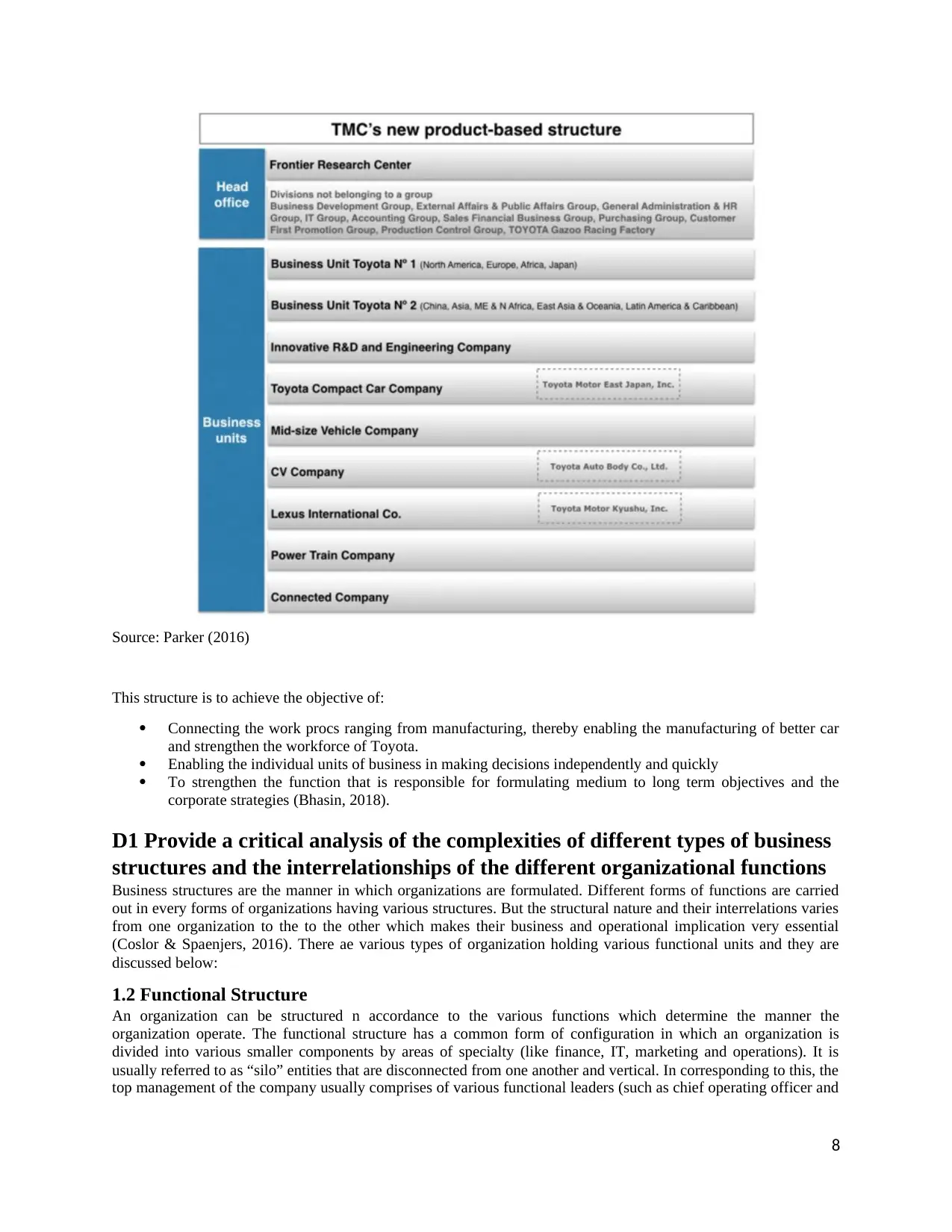
Source: Parker (2016)
This structure is to achieve the objective of:
Connecting the work procs ranging from manufacturing, thereby enabling the manufacturing of better car
and strengthen the workforce of Toyota.
Enabling the individual units of business in making decisions independently and quickly
To strengthen the function that is responsible for formulating medium to long term objectives and the
corporate strategies (Bhasin, 2018).
D1 Provide a critical analysis of the complexities of different types of business
structures and the interrelationships of the different organizational functions
Business structures are the manner in which organizations are formulated. Different forms of functions are carried
out in every forms of organizations having various structures. But the structural nature and their interrelations varies
from one organization to the to the other which makes their business and operational implication very essential
(Coslor & Spaenjers, 2016). There ae various types of organization holding various functional units and they are
discussed below:
1.2 Functional Structure
An organization can be structured n accordance to the various functions which determine the manner the
organization operate. The functional structure has a common form of configuration in which an organization is
divided into various smaller components by areas of specialty (like finance, IT, marketing and operations). It is
usually referred to as “silo” entities that are disconnected from one another and vertical. In corresponding to this, the
top management of the company usually comprises of various functional leaders (such as chief operating officer and
8
This structure is to achieve the objective of:
Connecting the work procs ranging from manufacturing, thereby enabling the manufacturing of better car
and strengthen the workforce of Toyota.
Enabling the individual units of business in making decisions independently and quickly
To strengthen the function that is responsible for formulating medium to long term objectives and the
corporate strategies (Bhasin, 2018).
D1 Provide a critical analysis of the complexities of different types of business
structures and the interrelationships of the different organizational functions
Business structures are the manner in which organizations are formulated. Different forms of functions are carried
out in every forms of organizations having various structures. But the structural nature and their interrelations varies
from one organization to the to the other which makes their business and operational implication very essential
(Coslor & Spaenjers, 2016). There ae various types of organization holding various functional units and they are
discussed below:
1.2 Functional Structure
An organization can be structured n accordance to the various functions which determine the manner the
organization operate. The functional structure has a common form of configuration in which an organization is
divided into various smaller components by areas of specialty (like finance, IT, marketing and operations). It is
usually referred to as “silo” entities that are disconnected from one another and vertical. In corresponding to this, the
top management of the company usually comprises of various functional leaders (such as chief operating officer and
8
⊘ This is a preview!⊘
Do you want full access?
Subscribe today to unlock all pages.

Trusted by 1+ million students worldwide
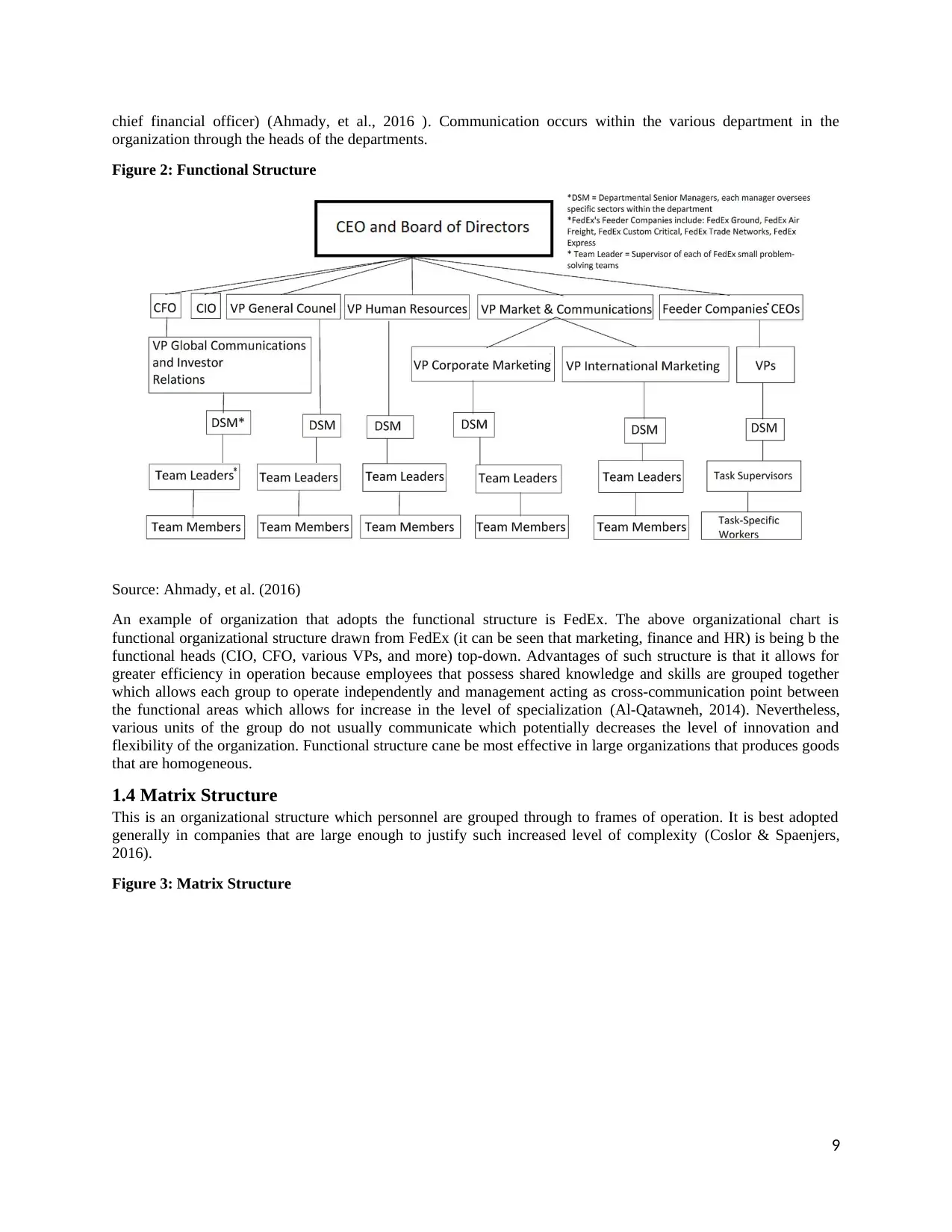
chief financial officer) (Ahmady, et al., 2016 ). Communication occurs within the various department in the
organization through the heads of the departments.
Figure 2: Functional Structure
Source: Ahmady, et al. (2016)
An example of organization that adopts the functional structure is FedEx. The above organizational chart is
functional organizational structure drawn from FedEx (it can be seen that marketing, finance and HR) is being b the
functional heads (CIO, CFO, various VPs, and more) top-down. Advantages of such structure is that it allows for
greater efficiency in operation because employees that possess shared knowledge and skills are grouped together
which allows each group to operate independently and management acting as cross-communication point between
the functional areas which allows for increase in the level of specialization (Al-Qatawneh, 2014). Nevertheless,
various units of the group do not usually communicate which potentially decreases the level of innovation and
flexibility of the organization. Functional structure cane be most effective in large organizations that produces goods
that are homogeneous.
1.4 Matrix Structure
This is an organizational structure which personnel are grouped through to frames of operation. It is best adopted
generally in companies that are large enough to justify such increased level of complexity (Coslor & Spaenjers,
2016).
Figure 3: Matrix Structure
9
organization through the heads of the departments.
Figure 2: Functional Structure
Source: Ahmady, et al. (2016)
An example of organization that adopts the functional structure is FedEx. The above organizational chart is
functional organizational structure drawn from FedEx (it can be seen that marketing, finance and HR) is being b the
functional heads (CIO, CFO, various VPs, and more) top-down. Advantages of such structure is that it allows for
greater efficiency in operation because employees that possess shared knowledge and skills are grouped together
which allows each group to operate independently and management acting as cross-communication point between
the functional areas which allows for increase in the level of specialization (Al-Qatawneh, 2014). Nevertheless,
various units of the group do not usually communicate which potentially decreases the level of innovation and
flexibility of the organization. Functional structure cane be most effective in large organizations that produces goods
that are homogeneous.
1.4 Matrix Structure
This is an organizational structure which personnel are grouped through to frames of operation. It is best adopted
generally in companies that are large enough to justify such increased level of complexity (Coslor & Spaenjers,
2016).
Figure 3: Matrix Structure
9
Paraphrase This Document
Need a fresh take? Get an instant paraphrase of this document with our AI Paraphraser
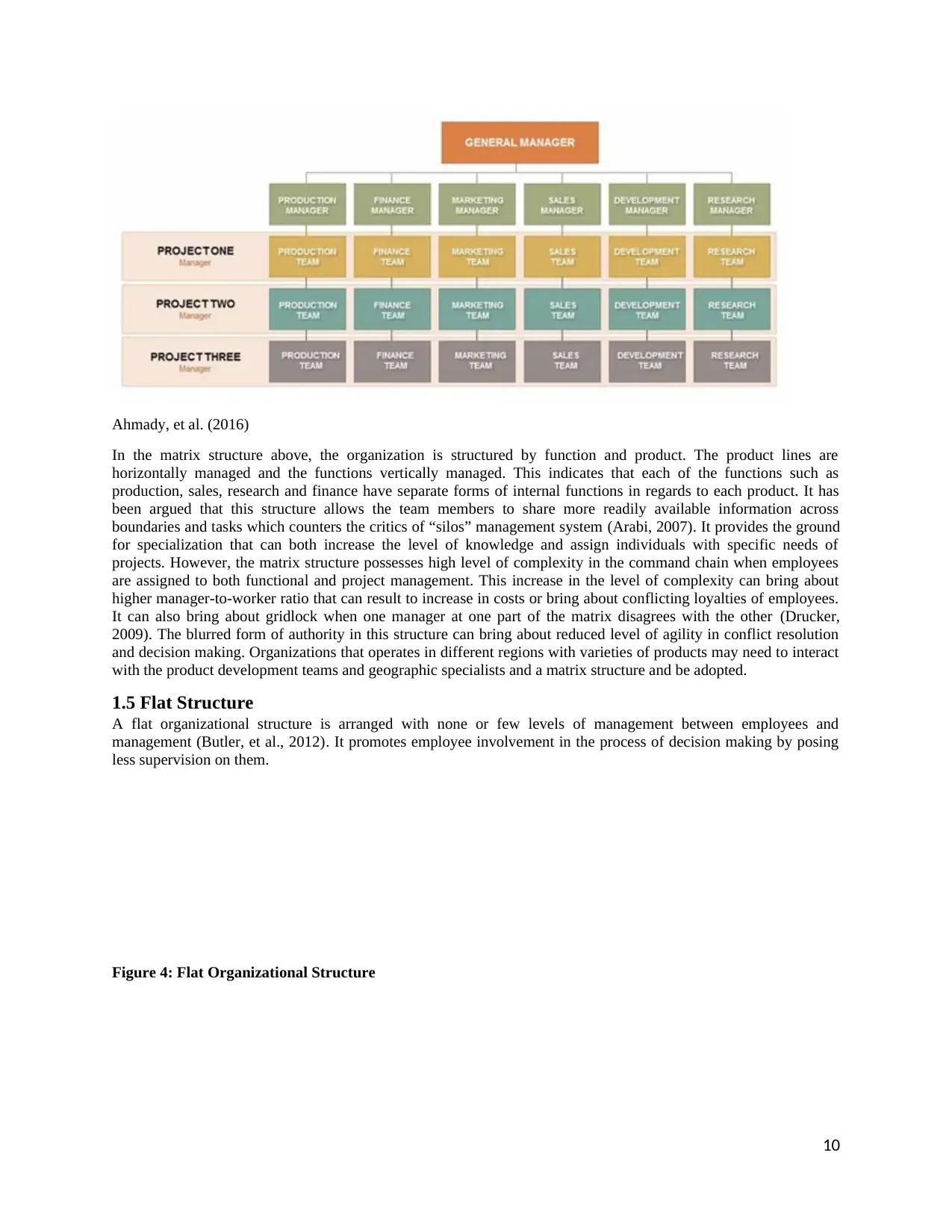
Ahmady, et al. (2016)
In the matrix structure above, the organization is structured by function and product. The product lines are
horizontally managed and the functions vertically managed. This indicates that each of the functions such as
production, sales, research and finance have separate forms of internal functions in regards to each product. It has
been argued that this structure allows the team members to share more readily available information across
boundaries and tasks which counters the critics of “silos” management system (Arabi, 2007). It provides the ground
for specialization that can both increase the level of knowledge and assign individuals with specific needs of
projects. However, the matrix structure possesses high level of complexity in the command chain when employees
are assigned to both functional and project management. This increase in the level of complexity can bring about
higher manager-to-worker ratio that can result to increase in costs or bring about conflicting loyalties of employees.
It can also bring about gridlock when one manager at one part of the matrix disagrees with the other (Drucker,
2009). The blurred form of authority in this structure can bring about reduced level of agility in conflict resolution
and decision making. Organizations that operates in different regions with varieties of products may need to interact
with the product development teams and geographic specialists and a matrix structure and be adopted.
1.5 Flat Structure
A flat organizational structure is arranged with none or few levels of management between employees and
management (Butler, et al., 2012). It promotes employee involvement in the process of decision making by posing
less supervision on them.
Figure 4: Flat Organizational Structure
10
In the matrix structure above, the organization is structured by function and product. The product lines are
horizontally managed and the functions vertically managed. This indicates that each of the functions such as
production, sales, research and finance have separate forms of internal functions in regards to each product. It has
been argued that this structure allows the team members to share more readily available information across
boundaries and tasks which counters the critics of “silos” management system (Arabi, 2007). It provides the ground
for specialization that can both increase the level of knowledge and assign individuals with specific needs of
projects. However, the matrix structure possesses high level of complexity in the command chain when employees
are assigned to both functional and project management. This increase in the level of complexity can bring about
higher manager-to-worker ratio that can result to increase in costs or bring about conflicting loyalties of employees.
It can also bring about gridlock when one manager at one part of the matrix disagrees with the other (Drucker,
2009). The blurred form of authority in this structure can bring about reduced level of agility in conflict resolution
and decision making. Organizations that operates in different regions with varieties of products may need to interact
with the product development teams and geographic specialists and a matrix structure and be adopted.
1.5 Flat Structure
A flat organizational structure is arranged with none or few levels of management between employees and
management (Butler, et al., 2012). It promotes employee involvement in the process of decision making by posing
less supervision on them.
Figure 4: Flat Organizational Structure
10
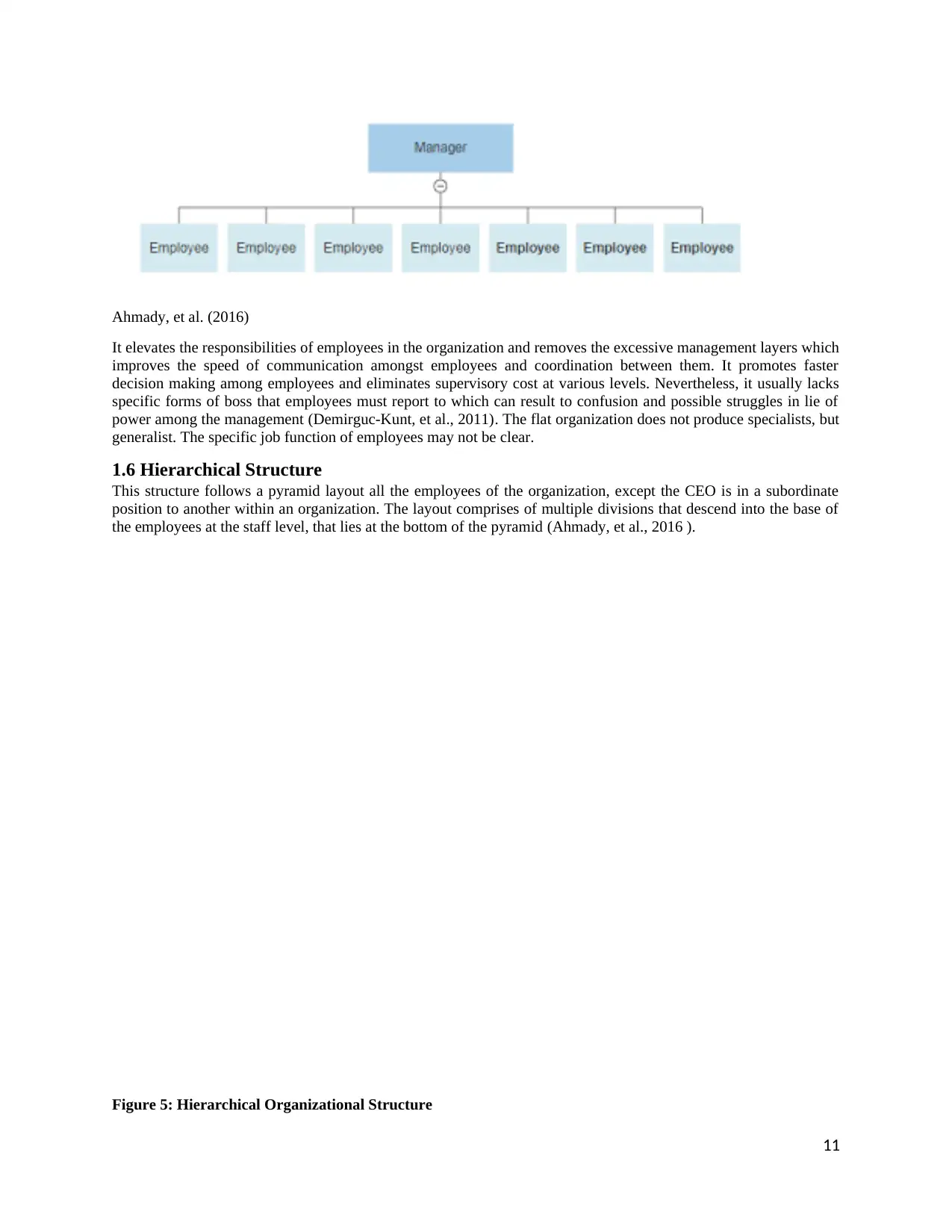
Ahmady, et al. (2016)
It elevates the responsibilities of employees in the organization and removes the excessive management layers which
improves the speed of communication amongst employees and coordination between them. It promotes faster
decision making among employees and eliminates supervisory cost at various levels. Nevertheless, it usually lacks
specific forms of boss that employees must report to which can result to confusion and possible struggles in lie of
power among the management (Demirguc-Kunt, et al., 2011). The flat organization does not produce specialists, but
generalist. The specific job function of employees may not be clear.
1.6 Hierarchical Structure
This structure follows a pyramid layout all the employees of the organization, except the CEO is in a subordinate
position to another within an organization. The layout comprises of multiple divisions that descend into the base of
the employees at the staff level, that lies at the bottom of the pyramid (Ahmady, et al., 2016 ).
Figure 5: Hierarchical Organizational Structure
11
It elevates the responsibilities of employees in the organization and removes the excessive management layers which
improves the speed of communication amongst employees and coordination between them. It promotes faster
decision making among employees and eliminates supervisory cost at various levels. Nevertheless, it usually lacks
specific forms of boss that employees must report to which can result to confusion and possible struggles in lie of
power among the management (Demirguc-Kunt, et al., 2011). The flat organization does not produce specialists, but
generalist. The specific job function of employees may not be clear.
1.6 Hierarchical Structure
This structure follows a pyramid layout all the employees of the organization, except the CEO is in a subordinate
position to another within an organization. The layout comprises of multiple divisions that descend into the base of
the employees at the staff level, that lies at the bottom of the pyramid (Ahmady, et al., 2016 ).
Figure 5: Hierarchical Organizational Structure
11
⊘ This is a preview!⊘
Do you want full access?
Subscribe today to unlock all pages.

Trusted by 1+ million students worldwide
1 out of 33
Related Documents
Your All-in-One AI-Powered Toolkit for Academic Success.
+13062052269
info@desklib.com
Available 24*7 on WhatsApp / Email
![[object Object]](/_next/static/media/star-bottom.7253800d.svg)
Unlock your academic potential
Copyright © 2020–2025 A2Z Services. All Rights Reserved. Developed and managed by ZUCOL.


